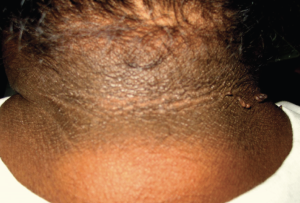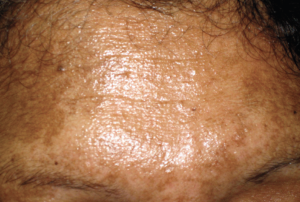Chapter 13: Disorders of Pigmentation
Hyperpigmented Lesions
Acanthosis nigricans
Acanthosis nigricans is not a skin disease but is a cutaneous sign of an underlying condition. It is characterized by hyperpigmentation and thickening of the skin, often with a velvety texture. This most commonly occurs on the posterior neck and axilla but can involve any skin folds. Most often this is associated with insulin resistance and can be seen in obesity or with poorly controlled diabetes mellitus. Treatment of acanthosis nigricans should be directed at correcting the insulin resistance including weight loss or change in diabetes treatment. To improve the appearance of existing plaques topical retinoids can be tried, but are often irritating.

Melasma
Melasma is often called the “mask of pregnancy.” It is most commonly seen in adult women and is very uncommon in males. The cause is not fully understood but is associated with hormonal changes such as pregnancy and oral contraceptives. It presents as asymptomatic hyperpigmented macules and patches with irregular borders on the forehead, cheeks, and upper lip. Melasma is commonly a cosmetic concern to patients but does otherwise not need to be treated. Sun protection is the most important component of treatment. Combination therapy with tretinoin, hydroquinone and hydrocortisone is often utilized. Other treatment options include azelaic acid, glycolic acid, kojic acid, and transexamic acid. Prolonged use of hydroquinone is not recommended as it can cause other forms of hyperpigmentation.

Retention Hyperkeratosis
Retention hyperkeratosis (terra firma-forme dermatosis) presents with reticulate hyperpigmentation that has a slightly velvety appearance. It has the appearance of dirty skin, but cannot be washed off with soap and water. It is caused by changes in keratinization and is not “dirty” skin. The hyperkeratosis can be removed with an alcohol wipe, which makes the diagnosis. Treatment is with use of an alcohol wipe, cream containing salicylic acid or lactic acid, or with gentle scrubbing using a washcloth or loofa pad.

